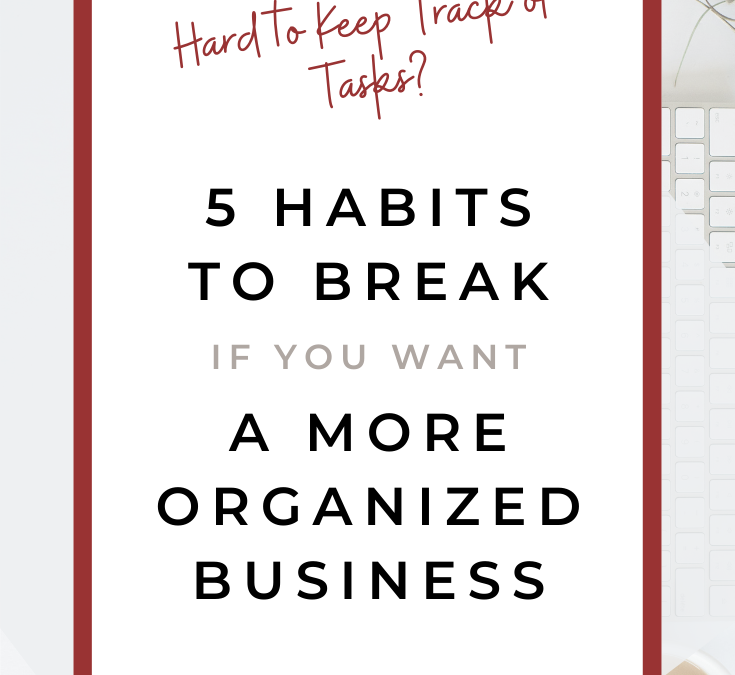
6 Signs You Need Better Project Planning
6 Signs You Need Better Project Planning for Your Business
Are you a big idea person who struggles to make your vision a reality? Do you find yourself scrambling to put together launches, presentations, and sales pitches right up to the last minute? Is your to-do list a pile of sticky notes sprinkled throughout your house? If you feel stuck, overwhelmed, or confused when it comes to project planning, raise your hand because you’re not alone.
As a Project Manager, I’ve worked with many clients who have fantastic ideas and businesses and the talent to pull it off, but they are still struggling to hit their goals. When that’s happening, usually it’s because there isn’t much focus on planning — or their current planning strategy isn’t working.
If this all sounds too familiar, here are a few signs that it’s time to take a new approach to planning projects within your business — and how you can make changes.
The Symptom: You’re rushing into big projects
If you always feel like you’re scrambling right up to the last second with big projects like launches, you’ve got a problem managing your time. You may need help with better scheduling or aren’t giving yourself enough time for each task. Do you even know how long certain tasks take to complete? If the answer is no, that’s a hint that you’ve got an issue.
The Treatment: Working backward
Open up your calendar, set a date for when you want to accomplish your next project, and then list out all the tasks. How long will each of those tasks take individually? Once you’ve got the list of everything you need, you’ll likely realize it takes more time than you think! For example, if you need to have a sales page up at least one week before launch, you have to have the design ready for review at least a few days before that and copy a few days before that. That’s going to change your timeline!
When you break down projects into action steps like this, you will realistically see when you need to start working on everything, so it launches on time (and without chaos). If you do this exercise and realize you should’ve started weeks ago, it’s a good sign you need to move the date out — or put in some extra hours to get it done.
The Symptom: You’re missing deadlines
Missed deadlines often can feel like big, red “F” marks (even when we’re long out of school). If you or your team keep missing deadlines, it’s easy to let frustration, shame, or guilt overrule your reaction. That’s why it’s especially important to dig into the “why” behind the missed deadlines with open communication—even if you’re only talking to yourself.
Treatment 1: Talk it out
Check in with a team meeting about what’s going on behind the scenes. Set and help keep a tone of open engagement and curiosity to steer away from potential finger-pointing or playing any blame game.
It’s often better to adjust the project plan than it is to force an otherwise trustworthy individual into a process that can’t work for them. Start by giving each member of your team my free Skills and Strengths Assessment to take stock of the gaps on your team, as well as their preferred communication methods (and how they prefer to be incentivized!)
Treatment 2: Hack your task management
If you’re using a task management system like ClickUp (full disclosure: that’s my affiliate link), Asana, or Teamwork, use their built-in features to keep things humming.
- Play tag! Build the habit for team members to “tag” the person affected when they’ve completed their task. Most systems allow you to tag team members by using the “@” symbol.
- Alternatively, if you’re a little more tech-inclined, set up task relationships (or “dependencies”) so that when one task gets completed, the next one in line becomes available.
- Use date ranges and time estimates. The way many of us use our task management apps means that we may only see a task appear on the day it’s marked “due”. And if a task takes a lot of time, that’s a missed-deadline guarantee. When assigning tasks, try to include a rough idea of how long it should take and, when possible, include a start date in addition to the due date.

The Symptom: You lack follow-through
A lack of follow-through can often more accurately be diagnosed as a lack of clarity. When I work with a client who struggles to stay motivated or doesn’t know what to do next, they usually have a few unanswered questions hiding in their plan. They can see their end goal but there are a few muddy areas when it comes to specifics.
Treatment 1: Move information out of your head with a brain dump
When you have no idea where to start, sometimes the easiest (and most helpful) action is taking all that stuff in your head and just getting it out. A simple brain dump is straightforward and so helpful! All you do is set a timer and start writing.
Don’t worry about formatting, ideas, or making it perfect. Put whatever words, phrases, diagrams, or thoughts you have floating in your head on the page. When the timer goes off, put it aside for a bit and then return to it.
When you come back to it, you’ll likely be able to take the ideas from your brain dump and organize them into a clearer plan for moving forward.
Treatment 2: Ask yourself two magic questions
Think about the place in your plan where you feel stuck and ask yourself:
If I were going to sit down right now to complete this task, could I? If not, why not?
Is there another job that actually needs to be done first? A decision that needs to be made or research that needs to be done?
With these new discoveries, ask the question again. Is that new task one you could do right now? If not, why not?
I envision this process as starting with a boulder (this big, unwieldy, heavy thing) and breaking it up into smaller pieces you can sort and handle easily. Make the pieces (tasks) as small as you need to make them until they feel doable.
The Symptom: Your team is stuck
If you feel like your team is spinning their wheels or constantly asking you what to do next, it’s time to get detail-oriented. Delegating tasks to your team isn’t as simple as saying, “Do this,” or “Do that.” You have to be specific about what you want, why you need it, and how it should be done. Otherwise, your team may not have enough to get the work done, or the work they turn in wouldn’t hit the mark.
The Treatment: Use Standard Processes (SOPs) and encourage questions
If you want your team to do the work as well as you would, you’ve got to give them the tools they need. A library of SOPs (aka Instruction Manuals, Team Processes, Operational Guides, How-Tos) comes in handy at times like this! Then, if your team needs to know how to do something, they can just look up the SOP. Also, encourage a collaborative, open environment so team members feel like they can ask questions when they need help!
The Symptom: Your work isn’t moving you closer to your goals
The whole point of owning your own business is to meet your goals. It’s why you set them in the first place. But if you find you’re spending hours and hours working, but you still aren’t closer to your overall goal, something’s not adding up. It’s either that your goals aren’t aligned with what you do or that your work doesn’t align with your goals.
The treatment: Track your time
Usually, when we aren’t seeing progress, we’re spending too much time on tasks that aren’t making an impact. For example, you will not reach revenue goals if you’re constantly sending emails to clients but not doing client work. So do a time study — track your time for an entire week and see where you spend your time.
If you realize you’re spending your time on things that can be outsourced, that may be your next step. On the other hand, if you realize that you’re spending time where you need to be, it might be time to evaluate your goals. Are they a bit of a stretch? Is it aligned with what you want to do? If the answer is no, it’s time to go back to the drawing board and set some new goals.
The Symptom: You’re doing work that you thought you “should” do
If you spend hours checking off tasks on a to-do list just because other businesses or your competitors are doing it – stop. Ask yourself, “Do I really need this? Does this help my business?’’ Stop wasting your time and energy on what you think you need to do, and focus instead on what you know you need to do.
The Treatment: Kill your darlings
When you do your time study, this will help you see where you’re spending time that isn’t helping. Remember, your time is an investment, and you need to get a good return on how you spend it. For example, you might realize that you don’t need to spend so much time making TikToks because they aren’t bringing in leads. Instead, you may realize that you need to spend MORE time creating LinkedIn content because that’s where your leads are coming in.
A final note on improving your project planning: Customize it!
Your business is unique, so why are you using the same old plans and processes as everyone else? There is no one-size-fits-all way to run. Instead, find what works best for your business and focus your time and energy there. Develop planning techniques and strategies that work for your needs. Otherwise, you’ll find that you’re running into these problems repeatedly without ever finding a solution.
If you aren’t sure what works best for you, let me help. My UNSTUCK program helps business owners find the support to develop planning strategies and processes that WORK for them. Together, we will find strategies to help you stay motivated and get work done, so you’ll feel less overwhelmed and stressed!















